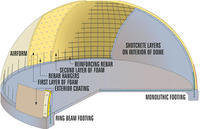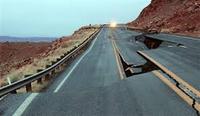-
Mississippi towns build tornado-proof domes

Following a devastating tornado two years ago, the town of Smithville, Mississippi, has started construction on a tornado-proof dome. The dome, to be built on the grounds of the local high school, will double as a gym and a storm shelter. Other towns in Mississippi have also begun their own dome projects.
-
-
Supercomputers allow for more realistic earthquake simulations
A team of researchers has developed a highly scalable computer code that promises dramatically to cut both research times and energy costs in simulating seismic hazards throughout California and elsewhere. The team performed GPU-based benchmark simulations of the 5.4 magnitude earthquake that occurred in July 2008 below Chino Hills, near Los Angeles.
-
-
Oregon citizens preparing for the Big One

A new study concludes that an earthquake of a magnitude 8.0 or above will strike off the coast of the state within the next fifty years. The Cascadia Fault, which runs from Northern California to British Columbia, Canada, causes a massive earthquake every 300 years or so, and the last time an earthquake hit the region was in the year 1700.
-
-
Making concrete “greener”

Many factors determine the overall energy and environmental impact of concrete. Reducing the amount of portland cement, which reacts with water to bind all the sand, stone, and the other constituents of concrete as it hardens, provides the biggest opportunity. Portland cement manufacturing accounts for more than 5 percent of U.S. industrial carbon-dioxide emissions. In addition, the U.S. cement industry consumes 400 gigajoules of energy annually.
-
-
House Intelligence Committee to work on cybersecurity bill in camera
The House Intelligence Committee will meet next week in order to draft a cybersecurity bill, known as the Cyber Intelligence Sharing and Protection Act (CISPA), but will not allow media members or the public to sit in on meetings during the process.
-
-
Fully secure communication
Can worldwide communication ever be fully secure? Quantum physicists believe they can provide secret keys using quantum cryptography via satellite. These physicists have, for the first time, successfully transmitted a secure quantum code through the atmosphere from an aircraft to a ground station.
-
-
Large robotic jellyfish to patrol the oceans

The Office of Naval Research wants to place self-powering, autonomous machines in waters for the purposes of surveillance and monitoring the environment, in addition to other uses such as studying aquatic life, mapping ocean floors, and monitoring ocean currents. Researchers have built a device for that purpose — a life-like, autonomous robotic jellyfish the size and weight of a grown man, 5 foot 7 inches in length and weighing 170 pounds.
-
-
Engineers educate lawmakers about aging U.S. infrastructure

Two hundred members of the American Society of Civil Engineering (ASCE) fanned out across Capitol Hill last month for the annual Legislative Fly-In with a message: U.S. infrastructure problems are solvable if we have strong leadership in Congress. The ASCE members highlighted the nation’s need to eliminate the backlog of infrastructure deficiencies, modernize roads, bridges, water systems, and energy grid – and reminded Congress that to promote commerce and protect public safety, welfare, and the environment, infrastructure investment is a priority issue.
-
-
Americans support preparation for extreme weather, coastal challenges: survey
The challenges posed by rising sea levels and increasingly severe storms will only intensify as more Americans build along the coasts. A just-released NOAA report predicts that already crowded U.S. coastlines will become home to an additional eleven million people by 2020. A Stanford survey finds that the majority of Americans support stronger coastal development codes. Among the most popular policy solutions: stronger building codes for new structures along the coast to minimize damage, and preventing new buildings from being built near the coast.
-
-
Obama promotes private-public infrastructure investment plan
President Barack Obama spent Friday afternoon at the Port of Miami where he announced his plan to attract private investment for big infrastructure projects. One such project is a $2 billion upgrading plan for the port. Obama also he would continue his push for a $100 billion infrastructure bank.
-
-
U.S. water infrastructure is in a serious state of disrepair
The U.S. water system is in a state of disrepair, and is deteriorating further every year for lack of money for maintenance and upkeep. The results include an estimated 240,000 water main breaks each year and nearly 14,000 dams — or one out of every seven dams — in the United States rated as “high hazard,” meaning that the flush of water from a broken dam would likely kill people.
-
-
Draft cybersecurity bill to increase penalties for hacking substantially
A draft of a cybersecurity bill circulating among House Judiciary Committee members would strengthen a computer hacking law. The draft would stiffen penalties for cyber crimes and establish a standard for companies to tell consumers when their personal information has been hacked. The bill would also change an existing law, making a cyber crime attempt punishable as an actual offense.
-
-
U.S. infrastructure grade raised from D to a D+, but problems loom
The American Society of Civil Engineers (ASCE), in its just-released 2013 Report Card for America’s Infrastructure, gave the U.S. infrastructure an overall grade of D+, showing slight progress from the D in the last Report Card issued in 2009. The Report Card concludes that to raise the grades and get U.S. infrastructure to an acceptable level, a total investment of $3.6 trillion is needed by 2020. Currently, only about $2 trillion in infrastructure spending is projected, leaving a shortfall of approximately $1.6 trillion.
-
-
Improved weather, climate predictions strengthen the U.S. economy
The economic costs of damaging weather events have an immense and increasing impact on the U.S. economy. These costs could be anticipated and mitigated by improved weather and climate predictions, say a range of experts in the public and private sectors. These experts will meet in early April in an American Meteorological Society event to discuss the economic benefits of how environmental forecast, prediction, and observation programs and services strengthen the U.S. economy.
-
-
Does warmer climate mean stormier, or only wetter, weather?
Many scientists argue that the climate has warmed since people began to release massive amounts greenhouse gases to the atmosphere during the Industrial Revolution. These scientists, however, are less sure that warming climate creates stormier weather. The reason: nobody has done the quantitative analysis needed to show this is indeed happening. Until now.
-
- All
- Regional
- Water
- Biometrics
- Borders/Immig
- Business
- Cybersecurity
- Detection
- Disasters
- Government
- Infrastructure
- International
- Public health
- Public Safety
- Communication interoperabillity
- Emergency services
- Emergency medical services
- Fire
- First response
- IEDs
- Law Enforcement
- Law Enforcement Technology
- Military technology
- Nonlethal weapons
- Nuclear weapons
- Personal protection equipment
- Police
- Notification /alert systems
- Situational awareness
- Weapons systems
- Sci-Tech
- Sector Reports
- Surveillance
- Transportation
Advertising & Marketing: advertise@newswirepubs.com
Editorial: editor@newswirepubs.com
General: info@newswirepubs.com
2010-2011 © News Wire Publications, LLC News Wire Publications, LLC
220 Old Country Road | Suite 200 | Mineola | New York | 11501
Permissions and Policies
Editorial: editor@newswirepubs.com
General: info@newswirepubs.com
2010-2011 © News Wire Publications, LLC News Wire Publications, LLC
220 Old Country Road | Suite 200 | Mineola | New York | 11501
Permissions and Policies
